Deseja um espaço seguro para fazer experiências com seu site WordPress sem medo de quebrar algo em seu site ativo?
Mover seu site WordPress para um servidor local em seu computador é a solução perfeita, em nossa opinião, especialmente para desenvolvedores, designers ou iniciantes em WordPress.
A instalação do WordPress em seu computador (servidor local) permite que você aprenda facilmente sobre o WordPress e faça testes. Ao mover um site WordPress ativo para um servidor local, você pode fazer experiências com os mesmos dados do seu site ativo.
Neste artigo, mostraremos como mover facilmente um site WordPress ativo para um servidor local.
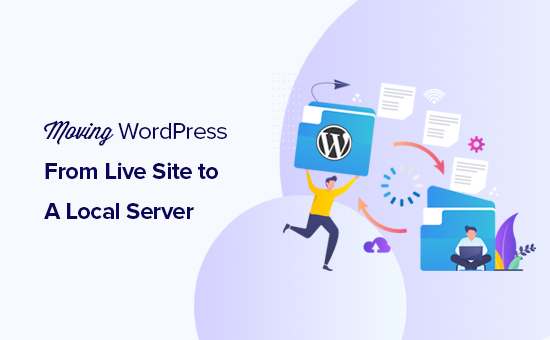
Por que e quem gostaria de mover um site WordPress ativo para um servidor local?
Se você já tem um site WordPress há algum tempo, talvez queira experimentar novos temas ou um plug-in. No entanto, fazer isso em um site ativo pode resultar em uma experiência de usuário ruim para seus usuários.
Para evitar isso, muitos usuários criam uma cópia do site WordPress em um servidor local para testar novos temas, plugins ou fazer testes de desenvolvimento.
Isso permite que você configure o tema com todo o seu conteúdo e teste todos os recursos sem se preocupar com a quebra do site. Muitos usuários copiam seu site para um servidor local para praticar suas habilidades de WordPress e de codificação com dados reais do site.
Embora você possa fazer todos os testes com conteúdo fictício no WordPress, os dados reais do site oferecem uma representação visual melhor de como essas alterações aparecerão no site ativo.
Preparação para mover um site local para um servidor local
Primeiro, você precisa garantir que sempre faça backup do seu site WordPress. Há vários plug-ins excelentes de backup do WordPress que você pode usar.
Em segundo lugar, você precisa instalar um ambiente de servidor local em seu computador. Você pode usar o WAMP para Windows e o MAMP para Mac. Depois de configurar o ambiente, você precisa criar um novo banco de dados usando o phpMyAdmin.
Basta acessar o seguinte URL em seu navegador para iniciar o phpMyAdmin.
http://localhost/phpmyadmin/
http://localhost:8080/phpmyadmin/
A partir daí, você precisa clicar na guia “Databases” (Bancos de dados) e criar um novo banco de dados. Você precisará desse banco de dados para depois descompactar os dados do site ativo.
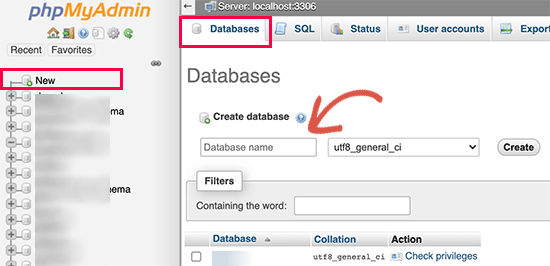
Agora você está pronto para mover seu site WordPress ativo para o servidor local.
Método 1. Como mover um site WordPress ativo para um servidor local usando um plug-in
Esse método é mais fácil e recomendado para todos os usuários.
A primeira coisa que você precisa fazer é instalar e ativar o plug-in Duplicator. Para obter mais detalhes, consulte nosso guia passo a passo sobre como instalar um plug-in do WordPress.
O Duplicator permite que você crie facilmente um pacote duplicado de todo o seu site. Ele pode ser usado para mover seu site WordPress para um novo local e também pode ser usado como um plug-in de backup.
Observação: Há uma versão gratuita do Duplicator com a qual você pode começar. No entanto, o Duplicator Pro vem com backups ilimitados e recursos mais avançados.
Após a ativação, vá para Duplicator Pro ” Backups na barra lateral do administrador do WordPress. Para criar um novo pacote, você precisa clicar no botão “Add New” (Adicionar novo).
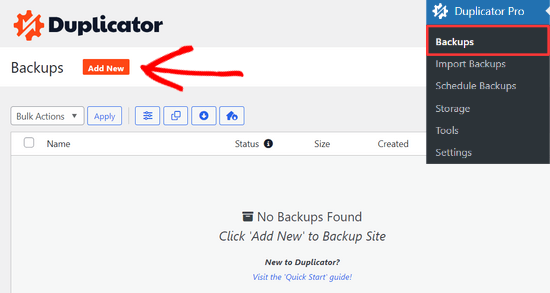
Em seguida, o Duplicator iniciará o assistente de backup.
Primeiro, você precisa inserir um nome para o seu pacote de backup. Você também pode usar as tags dinâmicas para criar automaticamente um formato de nome, como a data e o título do site.

Em seguida, expanda a seção “Storage” (Armazenamento) e escolha um local de armazenamento.
Para este tutorial, usaremos o local padrão. Você pode clicar no link “Add Storage” para adicionar um novo local, como o Dropbox ou o Google Drive, se desejar.
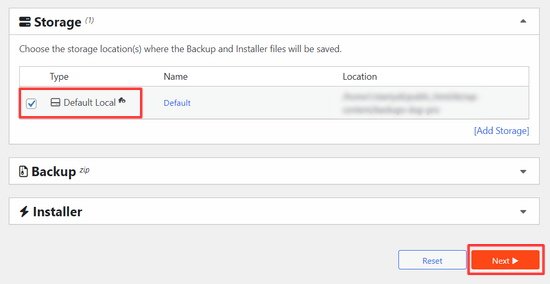
Clique no botão “Next” para continuar.
O plug-in fará uma varredura em seu site e executará algumas verificações em segundo plano. Em seguida, ele mostrará um resumo dessas verificações.
Se tudo estiver correto, clique no botão“Create Backup” para continuar.
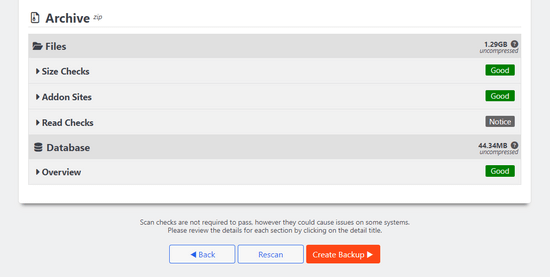
O Duplicator agora criará seu pacote de site.
Quando terminar, você verá um arquivo zip que contém todos os dados do seu site e um arquivo de instalação. Você precisa fazer o download de ambos os arquivos para o seu computador.
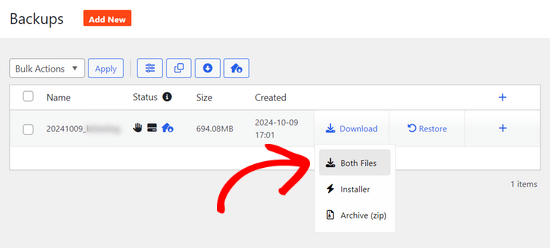
Agora você está pronto para descompactar e instalar esses arquivos em seu servidor local.
Primeiro, você precisa criar uma nova pasta na pasta raiz do seu servidor local. Essa é a pasta em que seu servidor local armazena todos os sites.
Por exemplo, se você estiver usando o MAMP, será a pasta /Applications/MAMP/htdocs/. Como alternativa, se você estiver usando o WAMP, será a pasta C:\wamp\www\.
Dentro dessa pasta, você pode criar novas pastas para cada novo site que deseja importar ou criar em seu servidor local.
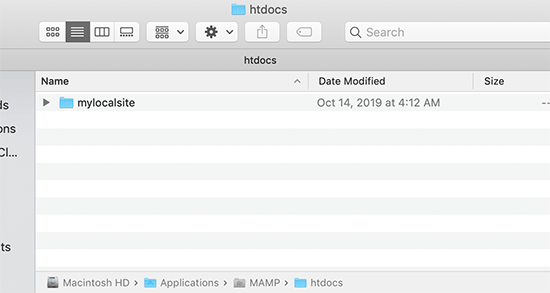
Depois disso, você precisa abrir a pasta criada para o site local e copiar e colar o arquivo zip e o script do instalador que você baixou anteriormente.
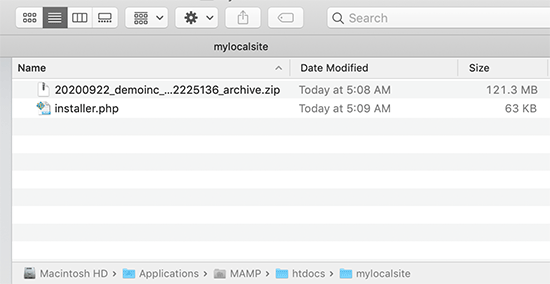
Para executar a instalação, é necessário abrir o script installer.php em seu navegador da Web.
Por exemplo, se você colou os dois arquivos na pasta /mylocalsite/, poderá acessá-los no navegador visitando http://localhost/mylocalsite/installer.php.
Agora você verá o script de instalação do Duplicator como este:
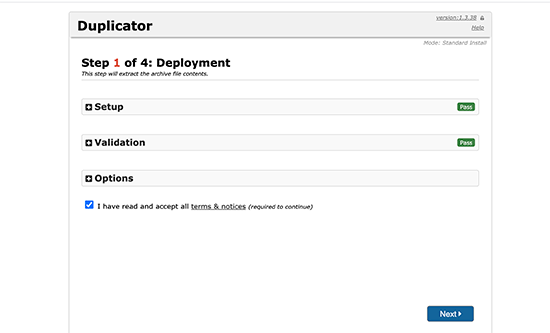
Clique no botão “Next” para continuar.
Agora, o Duplicator descompactará o arquivo zip e solicitará que você insira as informações do banco de dados do site local. Esse é o banco de dados que você criou anteriormente.
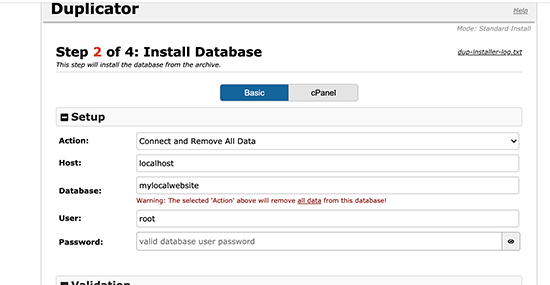
O nome do servidor é quase sempre localhost e o nome de usuário é root. Na maioria dos casos, a instalação do servidor local não tem uma senha definida para root, portanto, você pode deixá-la em branco.
Na parte inferior da página, você verá um botão “Test Database” (Testar banco de dados) que pode ser usado para garantir que as informações do banco de dados estejam corretas.
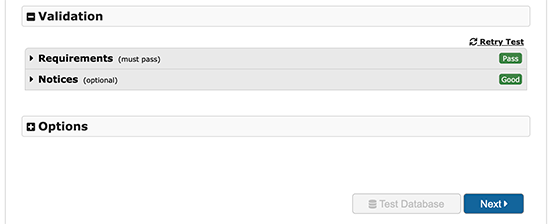
Se tudo estiver correto, clique no botão “Next” (Avançar) para continuar.
O Duplicator agora importará seu banco de dados do WordPress. Depois disso, ele solicitará que você verifique novamente as informações do novo site que ele detectou automaticamente.
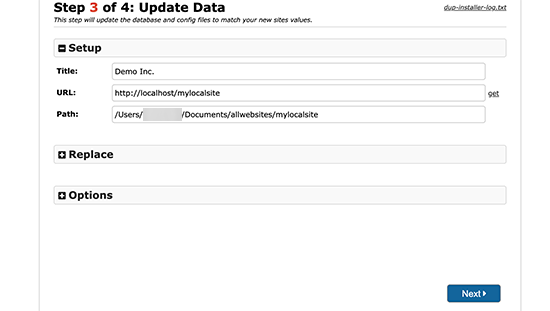
Clique no botão “Next” para continuar.
O Duplicator concluirá a configuração e mostrará um botão para fazer login no seu site local. Você usará o mesmo nome de usuário e senha do WordPress que usa em seu site ativo.
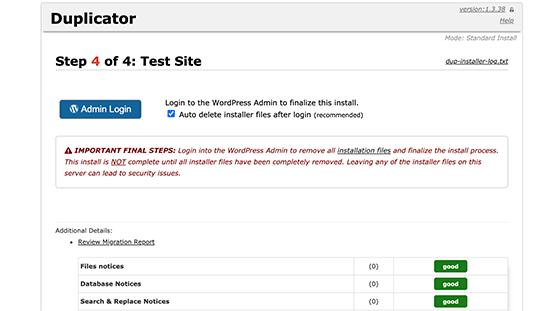
Isso é tudo, você conseguiu mover seu site ativo para o servidor local.
Método 2. Mover manualmente um site WordPress ativo para o servidor local
Caso o plug-in não funcione para você, é possível mover manualmente o site ativo para um servidor local. A primeira coisa que você precisa é fazer o backup manual do seu site a partir da conta de hospedagem do WordPress.
Etapa 1. Exportar o banco de dados do WordPress do seu site ativo
Para exportar o banco de dados do WordPress do seu site ativo, é necessário fazer login no painel do cPanel e clicar em phpMyAdmin.
Observação: Estamos mostrando capturas de tela do painel da Bluehost.
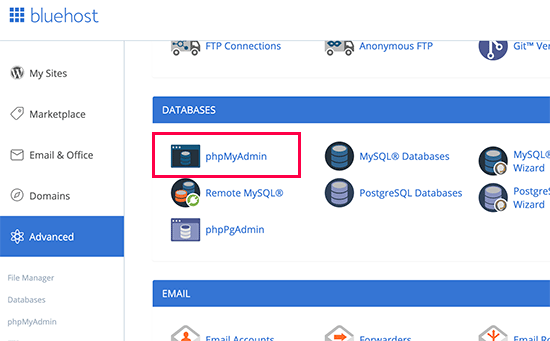
No phpMyAdmin, você precisa selecionar o banco de dados que deseja exportar e, em seguida, clicar na guia Exportar na parte superior.
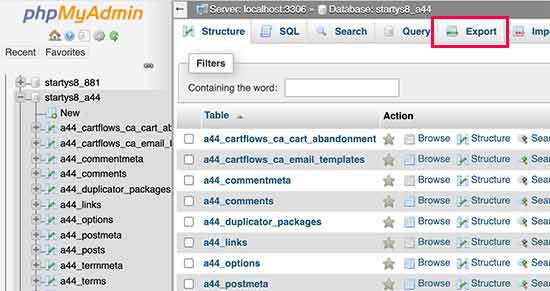
O phpMyAdmin solicitará que você escolha o método de exportação rápido ou personalizado. Recomendamos usar o método personalizado e escolher zip como o método de compactação.
Às vezes, os plug-ins do WordPress podem criar suas próprias tabelas no banco de dados do WordPress. Se você não estiver mais usando esse plug-in, o método personalizado permitirá que você exclua essas tabelas.
Deixe o restante das opções como estão e clique no botão “Go” (Ir) para fazer o download do backup do banco de dados em formato zip.
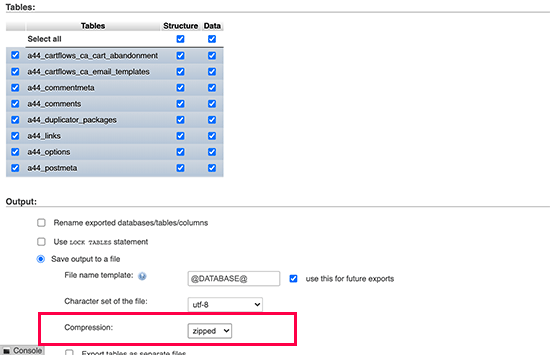
O phpMyAdmin agora fará o download do arquivo do banco de dados. Para obter mais detalhes, consulte nosso tutorial sobre como fazer backup do banco de dados do WordPress manualmente.
Etapa 2. Faça o download de todos os seus arquivos do WordPress
A próxima etapa é fazer o download dos arquivos do WordPress. Para isso, é necessário conectar-se ao site do WordPress usando um cliente FTP.
Depois de conectado, selecione todos os seus arquivos do WordPress e faça o download deles em seu computador.
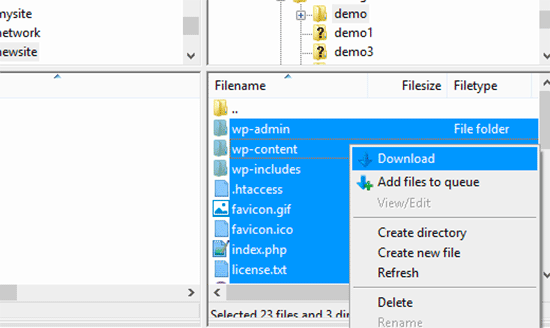
Etapa 3. Importe seus arquivos e banco de dados do WordPress para o servidor local
Depois de fazer o download dos arquivos do WordPress, você precisa criar uma pasta no servidor local para importar o site local.
Se você estiver usando o WAMP, deverá criar uma pasta dentro da pasta C:\wamp\www\ para o seu site local. Os usuários do MAMP precisariam criar uma pasta na pasta /Applications/MAMP/htdocs/.
Depois disso, basta copiar e colar seus arquivos do WordPress na nova pasta.
Em seguida, você precisa importar o banco de dados do WordPress. Basta abrir o phpMyAdmin em seu servidor local visitando o seguinte URL:
http://localhost/phpmyadmin/
Como você já criou o banco de dados anteriormente, agora precisa selecioná-lo e clicar na guia “Import” (Importar) na parte superior.
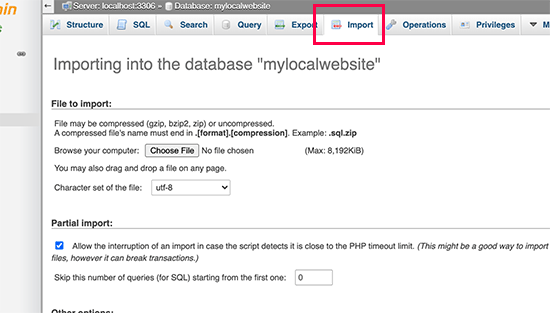
Clique no botão “Choose File” para selecionar e carregar o arquivo de exportação do banco de dados que você baixou na primeira etapa. Depois disso, clique no botão “Go” (Ir) na parte inferior da página.
O phpMyAdmin agora descompactará e importará seu banco de dados do WordPress.
Agora que seu banco de dados está configurado, você precisa atualizar os URLs dentro do banco de dados do WordPress que fazem referência ao seu site ativo.
Você pode fazer isso executando uma consulta SQL no phpMyAdmin. Certifique-se de ter selecionado o banco de dados do site local e, em seguida, clique em SQL.
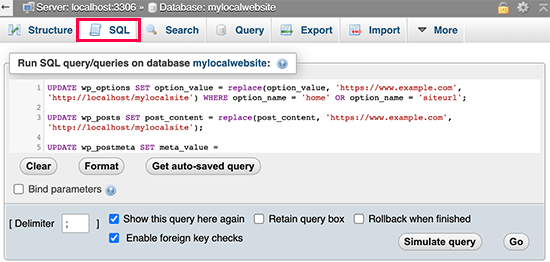
Na tela SQL do phpMyAdmin, copie e cole este código, certificando-se de substituir example.com pelo URL do seu site ativo e http://localhost/mylocalsite pelo URL do servidor local do seu site.
UPDATE wp_options SET option_value = replace(option_value, 'https://www.example.com', 'http://localhost/mylocalsite') WHERE option_name = 'home' OR option_name = 'siteurl'; UPDATE wp_posts SET post_content = replace(post_content, 'https://www.example.com', 'http://localhost/mylocalsite'); UPDATE wp_postmeta SET meta_value = replace(meta_value,'https://www.example.com','http://localhost/mylocalsite');
Essa consulta substituirá as referências ao URL do seu site ativo do banco de dados e o substituirá pelo URL do host local.
Etapa 4. Atualizar o arquivo wp-config.php
A etapa final é atualizar o arquivo wp-config.php de seu site local. Esse arquivo contém as configurações do WordPress, inclusive como se conectar ao seu banco de dados do WordPress.
Basta acessar a pasta onde instalou o WordPress em seu servidor local e abrir o arquivo wp-config.php em um editor de texto como o Bloco de Notas.
Substitua o nome do banco de dados pelo nome que você criou no phpMyAdmin em seu host local.
Depois disso, substitua o nome de usuário do banco de dados pelo seu nome de usuário local do MySQL, que geralmente é root. Se você tiver definido uma senha para o usuário root do MySQL em seu host local, digite essa senha. Caso contrário, deixe-o vazio e salve as alterações.
/** The name of the database for WordPress */
define('DB_NAME', 'database_name_here');
/** MySQL database username */
define('DB_USER', 'username_here');
/** MySQL database password */
define('DB_PASSWORD', 'password_here');
Agora você pode visitar o site local em uma janela do navegador inserindo o URL da seguinte forma:
http://localhost/mylocalsite/
Substitua “mylocalsite” pelo nome da pasta em que você copiou seus arquivos do WordPress.
Isso é tudo, seu site WordPress ao vivo está agora copiado para seu servidor local.
Esperamos que este artigo tenha ajudado você a aprender como mover facilmente um site WordPress ativo para o servidor local. Talvez você também queira consultar nosso guia sobre como criar facilmente um site de preparação para o WordPress para testes ou como mover um site do WordPress do servidor local para o site ativo.
Se você gostou deste artigo, inscreva-se em nosso canal do YouTube para receber tutoriais em vídeo sobre o WordPress. Você também pode nos encontrar no Twitter e no Facebook.





Jakob Uzioa
So i followed the instructions to manually move the site to the letter using wampserver but when i navigate to the file path localhost/mysite and hit enter, the site does not open but instead only a file downloads which is called. ” download” which is a php file:
/**
* Front to the WordPress application. This file doesn’t do anything, but loads
* wp-blog-header.php which does and tells WordPress to load the theme.
*
* @package WordPress
*/
/**
* Tells WordPress to load the WordPress theme and output it.
what could be the problem ?
WPBeginner Support
Please ensure you go through the installer.php when first installing the site and ensure WAMP is running as common possible reasons for that issue.
Admin
Tye
Thanks for the tutorial, its more clear than a lot of the ones I found online, I have a problem though, migration all fine, the site is running but I cannot login with the usernames I had on the live site, cannot access the admin dashboard to create new usernames either. Help please?
WPBeginner Support
If your users are not working then you could manually add a user following the steps in our article below. You would be able to use your file manager instead of FTP for a local installation.
https://www.wpbeginner.com/wp-tutorials/how-to-add-an-admin-user-in-wordpress-using-ftp/
Admin
Mark
Thank you for this tutorial, you run a very helpful website. It took me a long time to run through this, as there are alot of steps and I find a lot of ways to go wrong! I ended up using the file names that you used in your examples, to reduce complication. And success! Much appreciated.
WPBeginner Support
Glad our guide could help!
Admin
Lina
Thanks for the great tutorial! However, it only works for my home page. When I try to open a subpage, I see this error message: “The requested URL was not found on this server.” Can you help me here?
Best regards,
Lina
WPBeginner Support
It would depend on the method you used but we would recommend ensuring you used the SQL update as that should fix your URLs in your database. You may also want to ensure the links you are using in your menu are not custom URLs as that can be a common reason for that issue as well.
Admin
Awais
is the above code is right ?
I copy and paste in SQL but every time this massage comes,
0 rows affected. (Query took 0.0046 seconds.)
WPBeginner Support
The code should work but especially if you’ve already run it once, there will be no change in your site and it will come back with 0 affected.
Admin
Deb
Hi, thanks for your fab instructions. I used the Duplicator method and everything works…except when viewing the site my images/thumbnails don’t show up (broken image), until I click on them. Then they show in their own window, as expected.
They do show properly in the wp dashboard editor.
Cheers, Deb
WPBeginner Support
There are a few possible reasons but for a starting point you could try regenerating the thumbnails following our guide below as the most common solution for that error:
https://www.wpbeginner.com/plugins/regenerate-thumbnails-new-image-sizes-wordpress/
Admin
Aamir Khan
I have created a backup of my website manually and setup on local machine and run the above quires, but my website is redirecting to online version.
WPBeginner Support
It seems like you may have not updated the URL, you can do so using step 3 of the manual method of this article.
Admin
George
Thank you so much for this clear and useful article. I was able to follow it and migrate my WP site in less than 20 minutes – and I’m no expert. You’ve saved me a lot of pain – thank you.
WPBeginner Support
Glad our guide was helpful
Admin
Barry
Doesn’t work for me. I create the package, but it installs the basic WordPress files. So when I navigate to the folder it asks me to setup wordpress
WPBeginner Support
For the most common reason, you would want to ensure you are properly connected to the database, if you are not then it would show the option for creating a new site instead of showing the correct site.
Admin
Daniel
Nooo, its not working for me. pefrectly written tutorial and easy to follow (apart from it says hhttpps in the 3rd query)
i get this in my browser:
This site can’t be reachedlocalhost refused to connect.
Try:
Checking the connection
Checking the proxy and the firewall
ERR_CONNECTION_REFUSED
WPBeginner Support
Thanks for pointing out that typo, it should be fixed. For that error, you would want to ensure you updated your URL in step 3 correctly for the most common reason for that issue.
Admin
McKenzie
Thanks for your tutorial.
The front page is partially working but every other page is not working at all. Furthermore, it seems that front page is loading All the pages. What could be wrong?
WPBeginner Support
We would recommend starting by going through our troubleshooting guide below:
https://www.wpbeginner.com/beginners-guide/beginners-guide-to-troubleshooting-wordpress-errors-step-by-step/
Admin
Collins
Hi, Thank you for this super useful article.
I don’t know why mine doesn’t just work, I have done the exact same thing and gotten all the correct feedback. Whenever I try to open the home page localhost/site/ I get a page that doesn’t exist with the headers and footers and the rest of the pages still point to the live site.
WPBeginner Support
It sounds like you may have not set the URLs correctly. You would likely want to go to method 2 and try the SQL changes to update your URLs.
Admin
Murat
For those who are getting “wp_options doesn’t exist” error, you may have changed your table_prefix before. Just open the wp_config.php file and check $table_prefix = ‘wp_’
if the value isn’t “wp_” you get that error so when pasting the code edit it accordingly, for instance:
UPDATE xx_options SET option_value………..
WPBeginner Support
Thanks for sharing this should someone be running into that error
Admin
Chinwe
Thank you so much for this. It worked.
WPBeginner Support
Glad our guide was helpful
Admin
Ivana Spasic
When I copy and paste the code you provided to phpMyAdmin’s SQL screen, I am getting message: #1146 – Table ‘xyz.wp_options’ doesn’t exist.
How can this be fixed?
WPBeginner Support
You would want to ensure you have the correct database selected for the most common reason for that issue.
Admin
Jill
I used the Duplicator plugin to set up a copy of a website for a non-profit that I inherited. After reloading it so that all plugins are disabled I finally came to the conclusion that my site is attempting to use https:// to log in to the dashboard. To further confuse me, an empty site that I created on localhost does NOT use https:// for log in to the dashboard. I understand the value of https:// on the live site, but it appears there may be a way to disable it on localhost?
WPBeginner Support
For changing your local site’s URL you can follow our guide below and remove the s:
https://www.wpbeginner.com/wp-tutorials/how-to-change-your-wordpress-site-urls-step-by-step
Admin
Hazel beaver
Is there a plugin that allows you to download a zip file from the live site then upload into a fresh install of wordpress on the local host in a simpler way?
WPBeginner Support
For what it sounds like you’re wanting, the closest would be method 2 of this guide that you would want to take a look at.
Admin
Daniel
I successfully uploaded to localhost but when i try to use localhost/mysite_location/wp-admin, it redirects to the live site. Not the one on the localhost.
Need help
WPBeginner Support
You would want to go into your site’s database, go to the options table, and change your site url and address to localhost there. For how to modify your database you would want to take a look at our article here: https://www.wpbeginner.com/beginners-guide/beginners-guide-to-wordpress-database-management-with-phpmyadmin/
Admin
Bine
Great tutorial. It’s straight forward. Unfortunately I still get redirected to the dashboard as soon as I try to enter my URL. I followed all the steps but something must be missing. Does anyone has an idea what the problem might be? Cheers
WPBeginner Support
You may want to check your options table in your database to be sure that you didn’t set the site’s url to your wp-admin area
Admin
Niaz Muhammad
Great tutorial thanks for sharing your knowledge
WPBeginner Support
Glad you liked our article
Admin
alvaro hernandez
it works great!!! i love you!
WPBeginner Support
Glad our guide was helpful
Admin
T_WA
Hi, thanks for the tutorial, it’s was super helpful!!
However, after following all your steps, I have problems “establishing secure connection” (I guess because of the SSL) and thus it doesn’t work . I even tried and changed a line ‘DB_HOST’ to ‘localhost/localhost:8888’ in the wp-config.php that wasn’t mentioned in the video but didn’t help.
Also, when changing links I tried many variations nothing worked. Has someone faced a similar issue and found a solutions to it?
WPBeginner Support
Did you attempt to clear all of your caching after updating the URLs and is there the option to continue anyway under advanced on that error page?
Admin
Said
First of all thank you for theses clear explanations that I followed to the letter. The result is that i can access to to my site homepage locally, but links in this homepage do not seem to work because when I click on a link, for example :
localhost.mysite.com/subject.html
it is the following page that is displayed fir all links :
localhost/dashboard
Can you help me to resolve this problem
Thanks in advance
WPBeginner Support
It is likely due to your localhost not accepting pretty permalinks: https://www.wpbeginner.com/wp-tutorials/how-to-enable-custom-permalinks-in-wordpress-wamp-installation/
Admin
Ifthikar Hussain
Great Working, am facing a new problem which is i can access the only home page of my word press side. how can i able to access other pages??
WPBeginner Support
It would depend on what error you are running into. To get started you could take a look at the troubleshooting steps in: https://www.wpbeginner.com/beginners-guide/beginners-guide-to-troubleshooting-wordpress-errors-step-by-step/
Admin
Hannah
Hi there,
this is really easy to follow and helpful so thank you for that.
I do have a very straightforward question though.
When updating the URLs, you say to replace http:// example.com with your live site, but what if my live site uses https?
WPBeginner Support
If you’re moving your site to a local server we recommend http to avoid local installation issues with not having an SSL, you would change to https if you’re moving the content back to a live site that is using SSL.
Admin
Philip
Thanks. You wrote this article over 5 years ago, and it’s still good. I managed to set everything up nicely without too much trouble by following your manual instructions. Thanks in particular for the SQL queries.
Philip
WPBeginner Support
Glad our guide could be helpful and still works
Admin
Basem
After finishing the installation I click Admin Login button. the browser open new window to the installation of wordpress again? and the login page is not there
I checked the folders. all files are copied.
Patrick
Somebody find a fix for the localhost site copy (from live https) administration wanting to use https ?
dowlass
I found your instructions for the manual move of my site (from live server to localhost) worked pretty well. I had to do the permalinks thing – just click on ‘save’ without changing anything – to make links work properly. But otherwise it’s mostly good.
However, I’ve encountered a problem when trying to use new themes. If I add a new theme, then sure the theme installs ok and shows up on the theme page. However, if I try to preview or activate the new theme I just get a totally blank page – even the admin goes blank. The only recourse is to use the browser back button to get back to the admin view where I can delete the theme.
Adding new themes and trying to use them just makes the whole thing fall over!
Any ideas?
(p.s. I’m using a very old version of WordPress – 2.9.2…!! Which is the reason for wanting to play with it on localhost and work out the best way to upgrade.)
Michael
Tutorial worked pretty good but I had “internal Server Error”. I was downloading an entire network installation. I recopied the wp-config.php file because it had become compressed, all spacing removed. Then replaced the .htaccess with a fresh network version and that “RewriteBase /sitename/” was to the folder of the installation, instead of “RewriteBase /”
Emma
The instructions are clear and straightfoward but unfortunately I am having a total nightmare getting my site to work on the local server. After much trial and I’ve managed to get connect to the database and get some of the site content displayed but links aren’t working (they’re not found, apparently). I’m using MAMP Pro for Windows. Maybe I’ll try XAMMP – or using a Mac – instead. I think alot of the problem is to do with permissions but don’t really know where to start there seem to be so many fixes needed!
WPBeginner Support
Hi Emma,
If you can access the WordPress admin area, then try visiting Settings » Permalinks and then click on the save changes button without changing anything.
Admin
andy
I solve my problem. If you manually moved wordpress to localhost, and you install w3 total cache in your wordpress, you have to clear the browser cache after change database and wp-config. Or just open your localhost site with different browser.
andy
I have changed wp-config and all database url to localhost, but localhost still redirect me to live site. Why? I cannot install any plugin like duplicator anymore because the site already deleted
Suhana
Hi Andy
Have u tried changing the settings from wp dashboard?
Settings-> General->WordPress Address (URL),Site Address (URL)
Even if it shows the localhost address just save it and check. Hope it helps.
Patrick Pogi
Hi wpbeginner,
Thank you for the tutorial, it helps me a lot. I tried the manual install and but in the end it keeps redirecting me into wordpress installation page. Pls help me, i think i’m almost done. Im using xampp.
Thank you
Jason
Hi,
Im having issues while moving my site, it says LOCALHOST REFUSED TO CONNECT.
But my other local sites are okay.
Im moving it to local because something gone terribly wrong and my page woun’t load on the server’s.
Please any suggestion or advise is appriciated
John
In MAMP Preferences set your Ports to – Apache 80, Nginx 443 and MySQL 3306 and see if that fixes it
Steve
Thanks for this article, I found it very useful but would like to add to it if I may.
I used the manual method successfully with one exception, I could not navigate to any of the pages or posts from my sites menu. I would get a page not found error. I tried everything here, saving the premalinks, but nothing worked. I finally found a post elsewhere that gave me the solution. I had to modify a line in Apache’s httpd.conf file. Open the file and search for ‘AllowOverride’. If it looks like this: ‘AllowOverride None’, change it to ‘AllowOverride All’. I could not get to every page and post and see all the content!. FYI, there are several ‘AllowOverride’ options but the one you are looking for resides on a line by itself. I know this is a WordPress and not an Apache config forum but others may be experiencing the same issue. Hope this helps.
Braun Philippe
Hello Guys,
I’m running into a serious problem. When I click on my local site forler with servers ON on MAMP, it redirects to live site I’ve done everything this tutorial says, do you know where is the problem ?
I’ve done everything this tutorial says, do you know where is the problem ?
Thanks for your help
Sara
Hi
I am also having blank screen like IDRIS D…any suggestion
Idris D
Unfortuntely when I follow this guide, all the links in my local site redirect to the live site.
Any suggestions?
Adrian Stangell
Hi,
after following the instructions for the manual migration I end up with a blank screen when I try to access my website on the localhost. Any ideas?
Joel M
After running the SQL Query to replace links I receive a 1064 error – it seems there is a problem with the code syntax. I’m guessing it’s the (:) in my localhost url : ‘http://localhost:888/localwebsite’ – any ideas how I can work around this? I am using MAMP to run the local server.
Aaron L
try four ‘8’s instead of 3…. localhost:8888/localwebsite
Natalie Bell
Hi there!
I’ve had a successful migration to local site except for my Media Library, every picture is there (lots of files), url’s are correct, but when they don’t show up in the actual blog. When I go to media library it just shows the grid of the pics – all blank, but in description, url etc everything is correct.
Any idea what to do next?
Grant
Try going to your wordpress dashboard, click on the settings menu near the bottom of the sidebar on the left. Then click on the reading menu in the settings submenu, scroll down to the site visibility options and select the ‘allow search engines to index’ option and click save changes at the bottom of the page. See if that works, if not you may have to go to your terminal and manually pull media files from your old site recursively – I had to go this route and can walk you through it if you have any questions. Hope this helps
Carolina
Hi there, Thanks for the post, it’s a huge success for me.
So far, I’ve been able to get to the wp-login page.
and I’m sorry if this is a very silly question. but I’m really newbie with wp
my problem is I can’t login :$
I’ve tried the same logins as the live details = don’t work
as I haven’t set up the dashboard and it’s a local. no email will work.
what should I do?
btw, it’s on a mac.
Many thanks in advanced. Help is appreciated!!
WPBeginner Support
Hi Carolina,
You can change password using PHPMyAdmin.
Admin
DavidA
Hi again,
My sincere apologies! Posted a comment yesterday (July 24) re difficulty running the Duplicator program from my browser. Went back to check today and realised that I had made a mistake with the placement of the “test-site” folder which contained the installer.php and the zip archive database.
Once I truly placed this folder in the htdocs folder then everything worked fine and I was able to install the website data locally as per your instructions.
Thank you again for all your help!
DavidA
Hi — thank you again for another great article! All very helpful!
I am at the step of opening the Duplicator installer on my local computer. However when I put “http://localhost/test-site/installer.php” into my browser I get a “404 error message” saying “object not found”.
Interestingly if I use “localhost” alone or “localhost/phpmyadmin” they both work. I have moved the “test-site” folder to the “htdocs” folder but still does not work.
Any suggestions??
Thank you
Shun
Thanks for this guide, but what if you’re migrating from a live site with an SSL cert down to a dev site without SSL (https to http?)
I got the front-end working fine, however, HTTPS is still added to my wp-login URL, preventing me from accessing the login page into the admin.
Any additional steps required to eliminating https on a local/dev site’s WP login page?
simone
I am having a similar issue. I migrated a live site to MAMP using WP Migrate DB plug in and FTP. I get the following error – due to the live sites SSL Certificate. It has something to do with the database prefixes not matching. But – I cannot change the prefix on the live site, I called Go Daddy to see if I edited the live site prefix to match my local install database prefix if it would break the site, they said no guarantees, I tried it and it broke the site.
error message I get when entering localhost:8888 url.
An error occurred during a connection to localhost:8888. The client has encountered bad data from the server. Error code: SSL_ERROR_BAD_SERVER
The page you are trying to view cannot be shown because the authenticity of the received data could not be verified.
Please contact the website owners to inform them of this problem.
Thank you in advance for any help!
xasmatic
Well, i used SSL certificate and that is what I did:
At the step where you have to update the URLs inside your WordPress database referencing to your live site, you write the SQL query 4 times to change every URL that may exist.
First time write code like above “http://www.example.com”, then “http://example.com”, after that “https://www.example.com” and finally “https://example.com”.
Make sure: 1) that you write all four times the URL
http://localhost/test-sitewhich will replace those URLs2) change wp_options, wp_posts and wp_postmeta to your right ones (mine for example were cagwp_options etc.)
And a last reminder: Finally (if you’re moving on localhost), on the last step you have also to change the host name to localhost (wp_config.php file)
/** MySQL hostname */
define(‘DB_HOST’, ‘localhost’);
Veer Abheek Singh Manhas
I am tried using this article but I am not sure at which point of time i am supposed to install wordpress. Can anyone help me here?
Thanks
AIAI
you don’t have to reinstall wordpress again. all files from the source wp installation is already backed up.
Alex
I have used these instruction before and they worked fine, however i now have an updated version of mamp and wordpress and i continually get errors. betwen playing around i get the white blank screen or the index.php file. as text.
Both similar problems to users below.
it might be time to update this.
I gave up on moving my site to local and decided to just have a dev url too however, when i run the sql query above i always end up with a token missmatch, despite making all the necessary changes.
Andi
Thank’S a lot for your work.
But it doesn’t work. If I run local installer.php I see blank screen.
Best regards
Andi
mc
hey
I did everything as it is described and when I get to the last phase and put the url: localhost/mysite it automatically downloads a file that has this information:
<?php
/**
* Front to the WordPress application. This file doesn't do anything, but loads
* wp-blog-header.php which does and tells WordPress to load the theme.
*
* @package WordPress
*/
/**
* Tells WordPress to load the WordPress theme and output it.
*
* @var bool
*/
define('WP_USE_THEMES', true);
/** Loads the WordPress Environment and Template */
require( dirname( __FILE__ ) . '/wp-blog-header.php' );
is it something wrong that i did in the process?